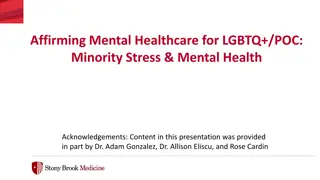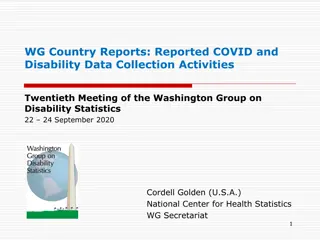Understanding the Impact of COVID-19 on Disability and LGBTQ+ Communities
This study examines the impact of COVID-19 on disability, LGBTQ+, and employment based on the 2021 Census Pulse Survey data. The research delves into population estimates, historical policy shifts, and statistical analysis of survey responses, shedding light on the challenges faced by these communities. The study emphasizes the importance of inclusive data collection to address the needs of diverse populations.
Download Presentation

Please find below an Image/Link to download the presentation.
The content on the website is provided AS IS for your information and personal use only. It may not be sold, licensed, or shared on other websites without obtaining consent from the author. Download presentation by click this link. If you encounter any issues during the download, it is possible that the publisher has removed the file from their server.
E N D
Presentation Transcript
The COVID-19 Impact on Disability, LGBTQ+, and Employment: An Examination of the 2021 Census Pulse Survey Chris R. Surfus, MBA, MPA, Ph.D. Postdoctoral Research Associate University of New Hampshire Institute on Disability/UCED
FUNDING & DISCLOSURE My postdoctoral position is funded by a $1 million federal grant from the Department of Health and Human Services, Administration for Community Living,National Institute on Disability, Independent Living, and Rehabilitation Research (NIDILRR) in the Advanced Rehabilitation Research and Training (ARRT) program, under grant 90AREM000401. I have consulted Debra Brucker, Ph.D. and Megan Henly, Ph.D., my colleagues at the UNH IOD, in the development of this presentation. I am a person with a disability and a member of the LGBTQ+ community doing research on disability and LGBTQ+ issues.
BACKGROUND In 2013, I wrote Equity Issues in LGBT Funding, which pointed out the funding gap for LGBT organizations in the United States. I pointed to the Horizons Foundation s estimate that 3.8 percent of Americans are LGBT. Policy Environment: 2015- Obergefell and Marriage Equality 2018- Masterpiece Cakeshop allowed business discrimination against LGBT for wedding cakes. 2020- Bostock and Employment Nondiscrimination with the 1964 Civil Rights Act as sex discrimination. Annual Gallup population estimates that 5.6 percent of Americans are LGBT. The most recent Gallup survey on the LGBTQ+ population showed that LGBTQ+ Americans are 7.1 percent of the population. This is a significant change in a single year, which makes me believe that there is a high level of error with the Gallup data.
BACKGROUND There is a need for a statistically precise population estimate for the LGBTQ+ community, those with disabilities, and those that are disabled that identify as LGBTQ+. The 2020 Census Pulse Survey excluded LGBTQ+ while Trump was President. Previously, Trump tried to exclude LGBTQ+ as part of the decennial census, as part of more than 70+ attacks on the LGBTQ+ community. In June 2021, the Biden Administration restored LGBTQ+ questions to the Census Pulse Survey.
METHODS I examined the data tables of Week 34 to Week 39 of the 2021 Census Pulse Survey after analyzing Week 35 in Stata. The table below shows each sample of approximately 60,000 to 70,000 survey participants as it relates to the LGBT population of the United States. Week 39 Week 38 Week 37 Week 36 Week 35 Week 34 7.69% 8.04% 7.78% 8.26% 7.58% 8.21% Average 7.93%
METHODS I applied weights using the provided replicate weights by the U.S. Census Bureau to Week 35 of the data, examining areas such as LGBT population, disability population, LGBT population with disabilities, COVID-19 vaccination rates, educational attainment, poverty, and work loss. After I wrote a paper on Week 35 of the data, I then began work to merge all six weeks of the Household Pulse Survey into a single dataset of 382,909 respondents. My LGBTQ+ population data matched the data tables provided by the U.S. Census Bureau. This aligns my data accurately with the data tables provided by the U.S. Census Bureau. I proceeded in creating variables for disability, transgender, LGBT with disabilities, and other categories.
FINDINGS LGBT POPULATION SIZE AND DISABILITY BY AGE Age Group Non-LGBT LGBT 18-25 26+ Total Disability Comparatively Non-LGBT & Disability LGBT & Disability 5.49% 94.51% 78.6% 21.4% 93.4% 92.1% 28.35% 71.65% 6.6% 7.9% Age Group Non-LGBT LGBT 18-25 26+ 12.2% 27.8% 13.5% 19.1% 13.4% 20.9%
FINDINGS LGBT POPULATION SIZE BY GENERATION Generation Non-LGBT LGBT Trad Boomer GenX Millen GenZ Total Total 6.1% 32.4% 12.7% 28.3% 18.8% 25.3% 41.0% 7.9% 24.9% 100% 100% 2.7% 5.8% 30.8% 27.5% 26.6% 9.2% 100%
FINDINGS LGBT POPULATION SIZE BY U.S. REGION Region Northeast South Midwest West LGBT Population 16.8% 35.5% 19.5% 28.3%
FINDINGS DISABILITY PREVALENCE: OVERALL Disabled Not Disabled DISABILITY PREVALENCE: LGBT IDENTITY 14.0% 86.0% LGBT + Disabled LGBT + Not Disabled LGBT Disability Prevalence Non-LGBT Disability Prevalence DISABILITY PREVALENCE: TRANSGENDER 1.7% 6.2% 20.9% 13.4% Trans Only + Disabled Trans Only + Not Disabled Trans Only Disability Prevalence Non-Trans Disability Prevalence 0.3% 0.5% 37.7% 13.8%
FINDINGS LGBT, DISABILITY, AND WORK LOSS DURING COVID-19 Job Status Currently Working in Past 4 Weeks Job Loss in Past 7 Days Job Status Currently Working in Past 4 Weeks Job Loss in Past 7 Days Non-LGBT LGBT Total 84.3% 15.7% 79.2% 83.9% 20.8% 16.1% Not Disabled Disabled Total 85.3% 14.7% 74.8% 83.8% 25.3% 16.2%
FINDINGS Employment Disability Not LGBT 29.8% 51.3% 58.5% 30.8% No Disability LGBT 18.3% 69.0% 67.8% 41.3% Work Loss (Past 4 Weeks) Any Work (Past 7 Days) Worked On-Site Teleworked LGBT Not LGBT 24.6% 39.1% 46.3% 19.9% 14.5% 60.3% 59.6% 32.2%
FINDINGS Variable Disability LGBT LGBT & Disability Transgender Vaccinated Mean 14.0% 7.9% Standard Error 95% Low 13.7% 7.8% 95% High 14.2% 8.1% 0.1% 0.1% 1.7% 0.892% 81.5% 0.05% 0.035% 0.1% 1.6% 0.823% 81.3% 1.8% 0.961% 81.8% Disability Types by Sexual Orientation and Gender Identity Comparatively Type Overall Non-LGBT Hearing 2.7% Seeing 3.9% Remembering 6.2% Mobility 5.7% LGBT Trans 2.6% 3.8% 5.4% 5.8% 3.0% 5.2% 14.8% 5.6% 9.1% 11.2% 27.1% 15.3%
FINDINGS Received COVID-19 Vaccine Disability Yes No 80.2% 19.8% LGBT Not LGBT 81.8% 18.2% Not LGBT 84.8% 15.3% No Disability Yes 88.9% 11.1% LGBT No
FINDINGS Mental Health Disability Not LGBT 72.4% 50.1% 41.9% 66.1% 44.5% 32.5% 65.3% 43.3% 29.9% 64.2% 40.8% 31.0% 51.0% 41.1% 30.9% 31.3% 17.1% 21.2% No Disability Disability No Disability LGBT vs. Not LGBT Disparity 22.3% 21.6% 22.0% 23.4% 9.9% 14.2% Not LGBT 20.2% 15.7% 13.8% 12.9% 17.9% 7.9% Anxiety Worried Loss of Interest Depressed Prescriptions Used Mental Health Services Could Not Get Mental Health Services LGBT LGBT 21.7% 16.8% 16.1% 18.1% 13.0% 13.2% 42.8% 22.3% 22.1% 8.0% 20.5% 14.1%
LGBT POPULATION PROJECTION Year LGBT percent LGBT population US Population 2031 7.7705% 24554898.5 2032 7.7806% 2033 7.7907% 25740345.5 2034 7.8007% 2035 7.8108% 26925792.5 2036 7.8208% 2037 7.8309% 28111239.5 2038 7.8410% 2039 7.8510% 29296686.5 2040 7.8611% Year LGBT percent LGBT population US Population 2022 7.6800% 2023 7.6901% 19813110.5 2024 7.7001% 2025 7.7102% 20998557.5 2026 7.7202% 2027 7.7303% 22184004.5 2028 7.7404% 2029 7.7504% 23369451.5 2030 7.7605% 356510992.5 359145326.8 361779661.1 364413995.4 367048329.6 369682663.9 372316998.2 374951332.5 377585666.8 380220001 19220387 332801984 335436318.3 338070652.6 340704986.8 343339321.1 345973655.4 348607989.7 351242324 353876658.2 25147622 20405834 26333069 21591281 27518516 22776728 28703963 23962175 29889410
LGBT POPULATION PROJECTION Projection of LGBT Population Increase from 2022 to 2040 7.9000% 7.8500% LGBT Population Percent 7.8000% 7.7500% 7.7000% 7.6500% 2031 2032 2033 2034 2035 2036 2037 2038 2039 2040
ADDITIONAL FINDINGS New findings yesterday from Anderson et al. (2021) from the U.S. Census Bureau: 38.2 percent of LGBT vs. 16.1 percent of non-LGBT experienced depression for more than half of the days in a week during the pandemic. 47.9 percent LGBT vs. 23.5 percent non-LGBT experienced anxiety for more than half of the days in a week during the pandemic. 59.4 percent of LGBT vs. 22.7 percent of non-LGBT were never married. 13.5 percent of LGBT vs. 7.4 percent of non-LGBT experienced food insecurity. Confirmed my findings on work loss, stating that 21.6 percent of LGBT vs. 16 percent of non-LGBT respondents experienced loss of employment. Confirmed my findings on LGBT population. Their figure is 7.7 percent which is also what I calculated, but theirs has missing data included.
REFERENCES Anderson, L., File, T., Marshall, J., McElrath, K., & Scherer, Z. (2021, November 4). New Household Pulse Survey data reveal differences between LGBT and Non-LGBT respondents during COVID-19 pandemic. Census.gov. Retrieved November 5, 2021, from https://www.census.gov/library/stories/2021/11/census-bureau-survey-explores-sexual-orientation-and-gender- identity.html?utm_campaign=20211104msacos1ccstors&utm_medium=email&utm_source=govdelivery. Badgett, M. V. L. (2018). Left Out? Lesbian, Gay, and Bisexual Poverty in the U.S. Population Research and Policy Review, 37(5), 667 702. Retrieved from, https://doi.org/10.1007/s11113-018-9457-5. Baumer, N. (2021, May 25). The pandemic isn t over Particularly for people with disabilities. Harvard Health. https://www.health.harvard.edu/blog/the-pandemic-isnt-over-particularly-for-people-with-disabilities-202105252464 Brownworth, V. A. (2020, October 20). The Intersection Of LGBTQ History And Disability. Philadelphia Gay News. Retrieved from, https://epgn.com/2020/10/20/the-intersection-of-lgbtq-history-and-disability/. Census Bureau is removing planned sexual orientation question from a national survey. (2017, September 27). National LGBTQ Task Force. https://www.thetaskforce.org/national-lgbtq-task-force-fights-trump-census-bureau- erasure/. Dawson, L., Kirzinger, A., & Kates, J. (2021, March 11). The Impact of the COVID-19 Pandemic on LGBT People. KFF. https://www.kff.org/coronavirus-covid-19/poll-finding/the-impact-of-the-covid-19-pandemic-on-lgbt- people/. Gallup. (2018, January 1). How Does the Gallup U.S. Poll Work? Gallup. https://www.gallup.com/224855/gallup-poll-work.aspx.
REFERENCES Gallup. (2021, February 24). LGBT Identification Rises to 5.6% in Latest U.S. Estimate. Gallup. Retrieved from, https://news.gallup.com/poll/329708/lgbt-identification-rises-latest-estimate.aspx. Natividad, I. (2020, April 24). Among the reasons COVID-19 is worse for Black communities: Police violence. Berkeley News. https://news.berkeley.edu/2020/04/23/one-reason-covid-19-is-worse-for-black-communities-police- violence/. Patterson, E., Hughes, M., Cray, A. & Hussey, H. (2015, July 30). Disability Justice Is LGBT Justice: A Conversation with Movement Leaders. Center for American Progress. https://www.americanprogress.org/issues/lgbtq- rights/news/2015/07/30/118531/disability-justice-is-lgbt-justice-a-conversation-with-movement-leaders/. Peterson, S., Toribio, N., Farber, J., & Hornick, D. (2020). Nonresponse Bias Report for the 2020 Household Pulse Survey. 28. Pilkington, E. (2020, May 20). Black Americans dying of Covid-19 at three times the rate of white people. The Guardian. https://www.theguardian.com/world/2020/may/20/black-americans-death-rate-covid-19-coronavirus. Rodriguez-Roldan, V. M. (2020). The Intersection Between Disability and LGBT Discrimination and Marginalization. Social Policy, 28, 12.
REFERENCES Schneebaum, A., & Badgett, M. V. L. (2019). Poverty in US Lesbian and Gay Couple Households. Feminist Economics, 25(1), 1 30. https://doi.org/10.1080/13545701.2018.1441533. United States Census Bureau. (2021-a). Household Pulse Survey Technical Documentation. Census.Gov. Retrieved September 30, 2021, from https://www.census.gov/programs-surveys/household-pulse-survey/technical- documentation.html. United States Census Bureau. (2021-b). Measuring Household Experiences during the Coronavirus Pandemic. Census.Gov. Retrieved September 30, 2021, from https://www.census.gov/householdpulsedata. United States Census Bureau. (2021-c). Week 34 Household Pulse Survey: July 21 August 2. Census.Gov. Retrieved September 30, 2021, from https://www.census.gov/data/tables/2021/demo/hhp/hhp34.html. United States Census Bureau. (2021-d). Week 35 Household Pulse Survey: August 4 August 16. Census.Gov. Retrieved September 30, 2021, from https://www.census.gov/data/tables/2021/demo/hhp/hhp35.html. United States Census Bureau. (2021-e). Week 36 Household Pulse Survey: August 18 August 30. Census.Gov. Retrieved September 30, 2021, from https://www.census.gov/data/tables/2021/demo/hhp/hhp36.html. United States Census Bureau. (2021-f). Week 37 Household Pulse Survey: September 1 September 13. Census.Gov. Retrieved September 30, 2021, from https://www.census.gov/data/tables/2021/demo/hhp/hhp37.html.























